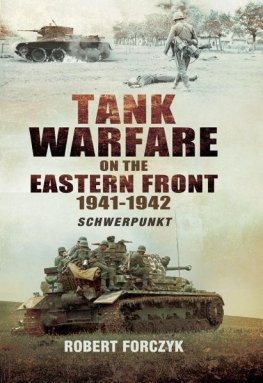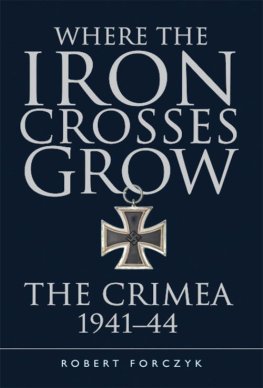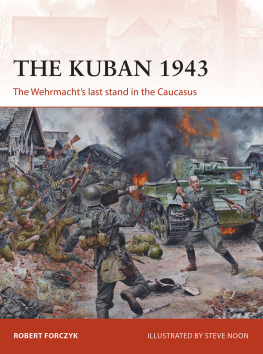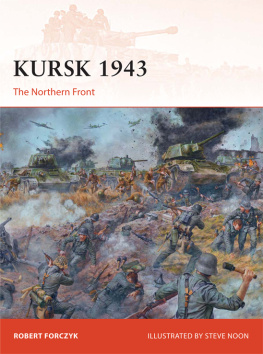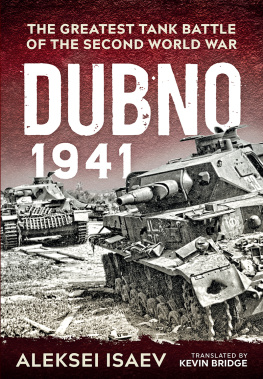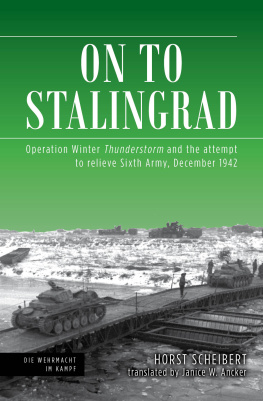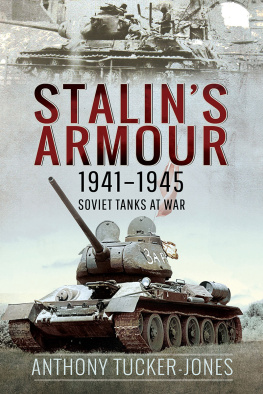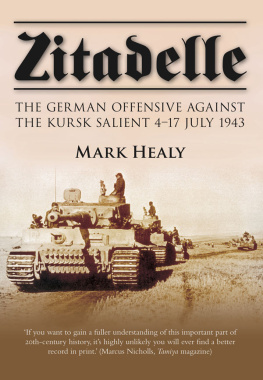Robert A. Forczyk
TANK WARFARE ON THE EASTERN FRONT, 19411942
SCHWERPUNKT
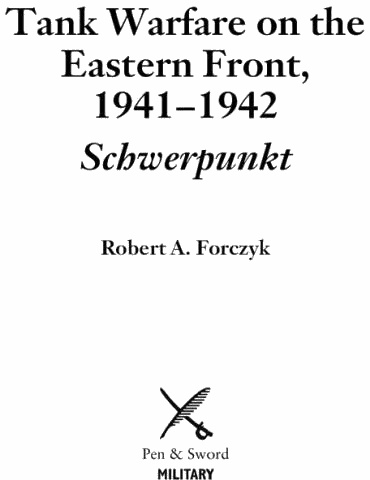
A mixed German armoured Kampfgruppe begins the attack into the Soviet Union.
Abandoned Soviet T-26 light tanks from Oborins 14th Mechanized Corps in Kobrin, 23 June 1941.
A knocked-out T-26 light tank and a victim of the early border battles.
A Pz.38(t) light tank from the 12.Panzer-Division, which was part of Hoths Panzergruppe 3.
A German infantryman approaches a dead Soviet tanker next to his burning BT-7 fast tank, Ukraine, June 1941.
A 15cm sIG 33 (sf), probably from 1.Panzer-Division, passes an abandoned KV-2 heavy tank in June 1941.
During the Battle of Dubno on 26 June 1941, the Soviet 12th Tank Division attempted to attack the German-held village of Leshnev, but advancing into marshy terrain along the Sytenka River they lost three T-34 tanks that got bogged down.
A T-34 Model 1941 which overran and crushed a German l.FH18 10.5cm howitzer.
A StuG III assault gun crossing a river in the early stages of Operation Barbarossa.
The hull of a KV-1 with at least four medium-caliber anti-tank round hits, which failed to penetrate, but a large-caliber artillery round, either 10.5cm or 15cm, has damaged the track.
A KV-1 heavy tank from the 124th Armored Brigade ambushed a German column northeast of Ivanovka on 9 October 1941.
Soviet tankers examine a Pz.38(t) light tank from the 7.Panzer-Division, abandoned near Yartsevo.
The onset of mud slowed down, but did not stop, German operations.
Soviet T-26 light tanks lead Timoshenkos counterattacks during the fighting near Smolensk in August 1941.
A Pz.III medium tank from 10.Panzer-Division, knocked out near Skirminova, east of Volokolamsk in mid-November 1941.
The last stage of Operation Typhoon began with German panzers attempting to batter their way through Rokossovskys final layer of defense outside Moscow.
A Soviet white-washed T-34 in hull-down position awaits the German panzers, near Volokolamsk, November 1941.
Polkovnik Mikhail G. Sakhnos tanks from the Moscow Proletarian Motorized Rifle Division move to a new position in the vicinity of Naro-Fominsk, December 1941.
Two overturned Matilda II tanks near Volokolamsk, 1 December 1941.
A T-34 tank moving at speed in deep snow.
The crew of a Pz.III tank from the 14.Panzer-Division watch German infantry clearing a village, mid-1942.
The interior of Hubes command vehicle, 16.Panzer-Division.
A Pz.III tank from 11.Panzer-Division in action during the opening stages of Operation Blau, 2830 June 1942.
An 8.8cm flak gun employing direct fire against Soviet armour.
A Pz.IV tank destroyed during the Second Battle of Kharkov in May 1942.
A Pz.III Ausf J with long 5cm gun.
An American-built Lend-Lease M3 Lee tank, shattered by 8.8cm anti-tank fire.
Tiger I heavy tank in August 1942.
A T-34 tank moving over rough terrain with infantry in desant role.
A Pz.IV Ausf G with long 7.5cm cannon in mid-1942.
A KV-1 heavy tank that overran a German reconnaissance car at the Battle of Ostrov.
A German Tauchpanzer III in testing.
Overview disposition of major German and Soviet armoured units at start of Barbarossa, 22 June 1941 and major battle sites, limit of German advance Von Schweppenburgs XXIV Armeekorps (mot.) crosses the Bug River and defeats Oborins 14th Mechanized Corps, 2223 June
Cherniavskys 1st Mechanized Corps versus Reinhardts XXXXI Armeekorps (mot.); Soviet 3rd Tank Division counterattack against 1.Panzer-Division at Ostrov, 56 July and delay back to Pskov, 79 July
Panzergruppe 1 executes the Uman encirclement against the Soviet 6th and 12th Armies, 15 July3 August
Yeremenkos Deep Battle, 30 August7 September; Group Ermakov, including 18th Tank Division attacks Lemelsens XXXXVII Armeekorps (mot.) in order to smash Panzergruppe Guderian
Overview the front line, 28 June 1942. German objectives, major tank battles of 1942 on the Eastern Front
Tank battles west of Voronezh, 28 June6 July 1942; Hoths 4.Panzerarmee versus multiple Soviet tank corps
Tank battles north of Orel, 512 July 1942
Hubes 16.Panzer-Divisions drive to the Volga, 23 August, and Soviet armoured counterattack, 26 August 1942
Kravchenkos 4th Tank Corps Advance to Kalach, 1923 November 1942
ABTU Auto-Bronetankovoe Upravlenie (Main Tank Directorate), 193440.
AFV Armoured Fighting Vehicle.
AOK Armeeoberkommando (Army).
AP Armour Piercing.
APBC Armour Piercing Ballistic Cap.
APHE Armour Piercing High Explosive.
C2 Command and Control.
cbm cubic meter of fuel, equivalent to 5,000 liters or 739kg.
DD Dalnoe deistvie (long-range tanks).
DPP Dalnia podderzhka pekhotny (Distant infantry support tanks).
Fliegerverbindungsoffizier Flivo, Luftwaffe liaison officer at Panzerarmee, created May 1942.
GABTU Glavnoe Avto-Brone-Tankovoe Upravlenie (Chief Department of Autos and Armoured Vehicles), 194045.
Gefechtstro Combat trains, including ammunition trailers.
Gepcktro Baggage train, including field kitchens.
GKO Gosudarstvennij Komitet Oboroniy (State Defense Committee).
Grotransportraum Large transport (GTR).
HEAT High Explosive Anti-Tank.
HKL Hauptkampflinie (main line of resistance).
Instandsetzungsgruppe Repair group.
Kradschtzen Motorcycle infantry.
LSSAH Leibstandarte SS Adolf Hitler.
MD Military District.
NKO Narodnyi Kommisariat Oborony (the Peoples Commissariat of Defense).
NKTP Narodnyi Kommissariat Tankovoy Promyslennosti (the Peoples Commissariat of the Tank Industry).
NKVD Narodnyi Kommisariat Vneshnykh Del (Peoples Commissariat of Internal Affairs).
NPP Neposredstvennaia podderzhka pekhoty (direct infantry support tank).
OKH Oberkommando des Heeres (German, Army High Command).
OTB (Independent Tank Battalion).
OTTPP Otdelniy Tyazhelij Tankovij Polk Proriva (Independent Heavy Tank Breakthrough Regiment).
PP podderzhka pekhoty (infantry support tanks).
Pz.Regt Panzer Regiment.
PZAOK Panzerarmee.
RKKA Raboche-Krestyanskaya Krasnaya Armiya (the Army of Workers and Peasants/the Red Army).
RVGK Rezerv Verkhovnogo Glavnokomandovaniya (Reserve of Supreme High Command).
SAP Samokhodno-Artillerijskij Polk (Self-Propelled Artillery Regiment).
SR Schtzen-Regiment [Motorized Infantry].
StZ Stalingrad Tank Factory.
TSAP Tyazhelij Samokhodno-Artillerijskij Polk (Heavy Self-Propelled Artillery Regiment).
TTPP Tyazhelij Tankovij Polk Proriva (Heavy Tank Breakthrough Regiment).
UMM Upravlenie Motorizatzii i Mekhanizatzii RKKA (Directorate of Mechanization and Motorization of the Red Army), 192934. Re-named ABTU.
VAMM Voennaya Akademiya Mekhanizatzii i Motorizatzii RKKA (Military Academy of Mechanization and Motorization of the Red Army).
V.S. Verbrauchssatz. A basic load of fuel or amunition.
Vorausabteilung Vanguard battalion (abbrev. V.A.).
In February 1986, amidst white-out conditions and sub-zero temperatures near the town of Yangpyeong in South Korea, I opened a wooden box that I was only supposed to open in the event of an emergency. Since my tank was alone on an independent reconnaissance mission with no other vehicles to assist, that emergency seemed to be at hand. In order to reach our battalions assembly area at the railhead, we had to climb a mountain road with a 30 slope, but every attempt had failed because our tracks slid on the snow and ice. The box came from Germany and it contained snow cleats that could be attached to the tanks tracks for added traction on snow and ice. They were built by Rheinmetall, the same company which had rushed tank cleats to the Russian Front during the winter of 194142.

